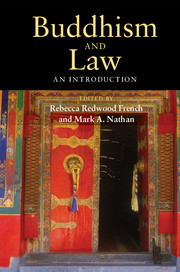Book contents
- Frontmatter
- Dedication
- Contents
- Maps and Illustrations
- Contributors
- Preface
- Abbreviations
- Introducing Buddhism and Law
- Part I The Roots of Buddhism and Law in India
- 1 Society at the Time of the Buddha
- 2 What the Vinayas Can Tell Us about Law
- 3 Keeping the Buddha’s Rules
- 4 Proper Possessions
- 5 On the Legal and Economic Activities of Buddhist Nuns
- Part II Buddhism and Law in South and Southeast Asia
- Part III Buddhism and Law in East Asia
- Part IV Buddhism and Law in North Asia and the Himalayan Region
- A Selection of Readings
- Index
- References
5 - On the Legal and Economic Activities of Buddhist Nuns
Two Examples from Early India
Published online by Cambridge University Press: 05 August 2014
- Frontmatter
- Dedication
- Contents
- Maps and Illustrations
- Contributors
- Preface
- Abbreviations
- Introducing Buddhism and Law
- Part I The Roots of Buddhism and Law in India
- 1 Society at the Time of the Buddha
- 2 What the Vinayas Can Tell Us about Law
- 3 Keeping the Buddha’s Rules
- 4 Proper Possessions
- 5 On the Legal and Economic Activities of Buddhist Nuns
- Part II Buddhism and Law in South and Southeast Asia
- Part III Buddhism and Law in East Asia
- Part IV Buddhism and Law in North Asia and the Himalayan Region
- A Selection of Readings
- Index
- References
Summary
Re-visioning the Indian Buddhist Nun as a “Legal Person”
One of the most obvious limitations of even recent work on the economics and business or corporate law of Buddhist monasticism in early India has been its almost exclusive focus on male monasticism, on male monasteries and monks. Nuns and nunneries have once again been overlooked or dropped between the cracks. There is, of course, no good reason for this, especially since it has been clear for some time from Buddhist inscriptional records that up until the Gupta period, at least, nuns were as active as donors at Buddhist sites as were monks, and must therefore have had very considerable means and economic presence. Even more recently it has also been noted that, although textually nuns may have been hierarchically or ritually subservient to monks, this had – according to at least one Vinaya or monastic code – no bearing on their legal or economic status: for this Vinaya, nuns had equal legal rights of ownership and economic independence. This same Vinaya, the Mūlasarvāstivāda-vinaya, or closely related texts, moreover, deals with nuns who engage in a wide range of business enterprises, both licit and – according to the male authors of this code – illicit, and who have at their disposal and use a series of sophisticated financial instruments. A comprehensive, detailed survey of all of this would be, of course, of considerable interest and importance for any future view of the Indian Buddhist nun, but such a survey is hardly possible now, and certainly not here. The investigation of these issues has just begun; the sources we must use are in some disarray and more often than not very difficult, and the basic legal vocabulary is barely understood. Here, then, we can only make a start on two topics that will come to form a part of any such future survey: the use of negotiable promissory notes by Buddhist nuns, and their involvement in lending on interest funds that they held as permanent endowments. These two topics alone will amply illustrate the difficulties involved in pursuing these kinds of investigations, and will all too elegantly reveal how very far we have yet to go.
- Type
- Chapter
- Information
- Buddhism and LawAn Introduction, pp. 91 - 114Publisher: Cambridge University PressPrint publication year: 2014



